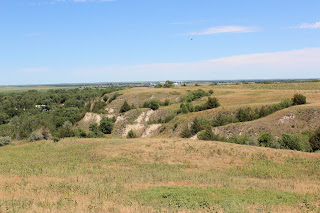Sunday Stories: Early History - O'Fallons Bluff
Excerpted from the 1891-1991 Sutherland Centennial

During its brief history (1860 – 1861) the Pony Express Route near Sutherland traversed basically the route of the Oregon-California Trail. A Pony Express station just west of O’Fallons Bluff is identified as Dorsey’s, Dansey’s, D’Orsay’s, Halfway House or Elkhorn Station. It is located at the headquarters of Seifer Farms Pasture Poultry.
O’Fallons Bluff was a famous landmark all of the travelers
referred to. When they first encountered O’Fallons Bluff, the river ran along
the base of the bluff. A horseman could hardly ride between the water and the
steep face of the bluff. This was a dreaded place for travelers because it was
the best place for Indians to hide. Wagons would converge on the area from
along a fairly wide path, but then be forced to merge into one lane to get
between the bluff and the river. Everything would get backed up, tempers would
flare and drivers would be compared to their oxen.
O’Fallon’s Bluff was named for Benjamin O’Fallon. He was
born in Kentucky in 1793 and was raised by his uncle, William Clark of the
Lewis and Clark expeditions. As an army major he assisted General Atkinson in
negotiating the first treaty with the Indians west of the Mississippi river in
1819. During the summer of 1825, he was appointed by the President of the
United States to serve as an Indian Agent. The Indians trusted him because he
understood them and their problems. He resigned this post in 1827 and entered
into fur trading. It was during this period of his life that he lived for a
time in a cave in the Bluff and led several expeditions through this area.
Beginning in 1843, there were large numbers of travelers on
the Oregon branch of the Oregon – California Trail. Many early travelers from
Omaha or Council Bluffs took the “North Side Road”. In 1847, the Mormon
Pioneers commenced using segments of this trail in their historic trek to the
Great Salt Lake, and in 1848 there was a mass exodus of Mormons from the winter
quarters near Omaha traveling along the North Platte River north of Sutherland
where ruts can still be seen.
The year 1849 was the beginning of the California Gold Rush
with would-be fortune seekers trekking through Nebraska either on the Oregon –
California Trail or the Council Bluffs Road – Mormon Trail to the cut-offs
further west. It is estimated that in the year 1849, 30,000 travelers passed
through on these routes.

During its brief history (1860 – 1861) the Pony Express Route near Sutherland traversed basically the route of the Oregon-California Trail. A Pony Express station just west of O’Fallons Bluff is identified as Dorsey’s, Dansey’s, D’Orsay’s, Halfway House or Elkhorn Station. It is located at the headquarters of Seifer Farms Pasture Poultry.
During the years 1858 to 1860, in the area of O’Fallons
Bluff there was a trading post, stage station and Post Office. There were a few
cottonwood trees and two young men by the names of Moore and Grimes ran the
west station. It was described as one of the best on the road. It had an
abundance of hay for travelers and almost every article that would be required
for the journey. Wood was also available here, being the last opportunity to
get it for nearly 100 miles. The station was believed to have been started by
Mr. I.P. Boyer.
In the winter of 1864-65, the stage station was burned along
with other damage inflicted by the Indians. Stage drivers witnessed the burning
of the Stations at O’Fallon’s Bluffs and Willow Island by the Indians and
within twelve hours the burning of Butts and Alkali stations. In their raids a
vast amount of property was destroyed and a great deal of stage stock stolen.
Henry Carlyle gave this account of an incident at the Bluffs:
“… The coach was full of mail. As we came near to one of the road ranches in
the vicinity of O’Fallons Bluff, some distance west of Cottonwood Springs, we
found that the Indians had captured it, had rolled out a barrel of whiskey and
knocked the head in, and were drinking it out of tin cups. The whole band were
in the midst of a drunken revelry. The driver was greatly alarmed and suggested
that we run by at full speed. But I said, ‘No! Nothing Doing. Do nothing
unusual to attract their attention. You are in the habit of watering here.
Drive right up at the regular gait and water as usual. Above all keep cool,
keep your seat and have your team in hand. I will get down with the bucket and
water the team.’ My last words before getting down from the box were to urge
the importance of keeping cool. ‘If we are lucky enough to get away from here
we will let the team out’ (meaning full steam ahead.). These Indians have been
lying in the bluffs for days. They have watched the coaches come and go and
know all the movements along the valley.” The whiskey and Carlyle’s tact and
good judgment saved all from being horribly butchered.
In 1867, the O’Fallons railroad siding, depot and post
office were built north of the river opposite the east part of the bluffs. It also
included a trading post and saloon.






Comments
Post a Comment